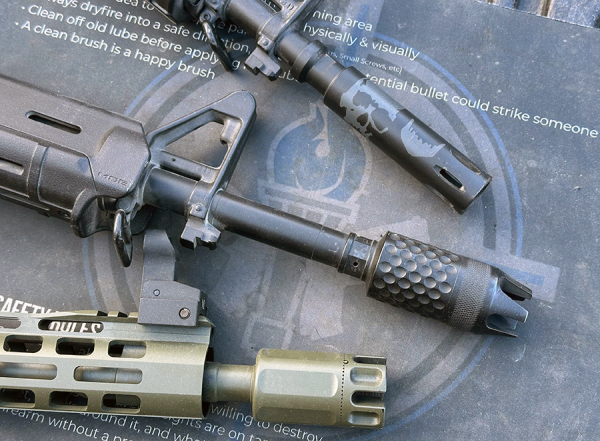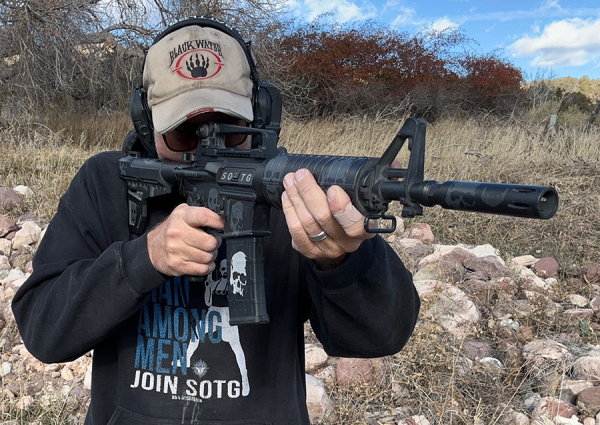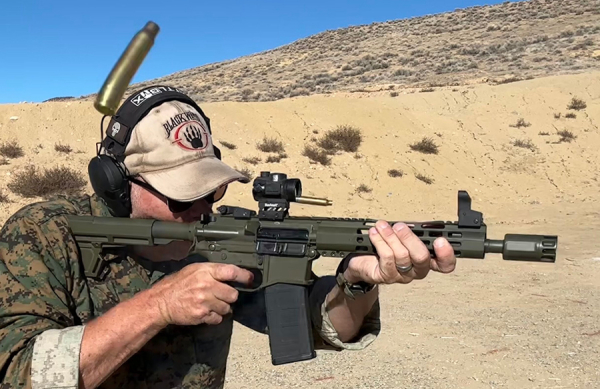
Despite what the naysayers had to say a decade or so back, the RCP — rifle caliber pistol — is here to stay. Yes, I fully understand that we’re playing a semantic game by calling these firearms rifle caliber pistols. That’s what you get when the citizens of the United States grow weak and apathetic and allow criminals in government to circumvent the US Constitution, but that’s a conversation for another day.
For today, let’s consider RCPs and their relatively short barrel lengths when compared to traditional rifles chambering the same cartridges, shall we?
Gas Control
That name of game, particularly when it comes to semi-auto firearms is “gas control.” When we were using semi-autos with 20-inch barrels, as were standard on the original AR-15s, a simple flash hider/compensator, such as the ubiquitous “birdcage” design worked just fine. The split brake on the front of the XM16E1, despite being decried by troops in the jungle for catching on vines, actually worked very well. Gene Stoner and his team were smart guys.
However, as the barrels got shorter and the noisy end got closer to the shooter’s face other options were explored. Keep in mind, for a relatively small caliber, the .223/5.56mm has a sharp report. Though a simple AR-15 birdcage flash hider might have worked, even with the short 16 and 14.5 inch barreled M4s, when the length drops down to sub 1 foot barrels, we need something out front to push the gas away from the shooter’s face and to help reduce the flash.
Yes, you can buy a suppressor, but there are still valid reasons why not everyone has such a device. What we will examine here are some over-the-counter muzzle devices that can aid us in our desire to direct the noisy, expanding propellant gasses away from our face and by extension, the faces of people who might be on our right or left.
Those who think that this is no big deal likely haven’t been around those who either fire rifle caliber guns with no device at all or with a “competition brake” in place. Several years ago, I was in a rifle class with two shooters who had “compliant” AR rifles with bare muzzles…no gas-taming devices. The noise coming out of those guns was, shall we say, quite rude. The instructor moved them to the far end of the line.
The polar opposite of no device are “competition brakes” that have a tendency to not only make .223 even louder, if such a thing is possible, but they push the gas to the sides, other shooters be damned. Yes, I know brakes don’t necessarily increase the shot noise, but they push the noise back toward the ears of the shooter and others around them, not away from them. The sound perception is very real.
XM177E2 Flash Hider
Let’s begin with what can rightly be called the OG of muzzle devices for short barrels, the XM177E2 flash hider. This design dates back to the Vietnam war era and the desire by Colt Mfg. to create a smaller/more compact version of the M16A1. The original XM177E2 had an 11.5-inch barrel and so the makers needed a newer, improved flash hider to both dampen the flash of 5.56mm ammo and to push the noise away from the shooter’s face.

A few years back, I built an AR pistol with an 11.5-inch barrel and the muzzle device I installed was the XM177E2 flash hider from Brownells. The design is relatively simple but it works really well for both directing the noise away from the shooter toward the target as well as dampening the flash in low light. The XM177E2 flash hider is threaded for .22 caliber barrels in a 1/2×28 TPI pattern.
Spike’s Tactical Barking Spider
Next up is a muzzle device with both a unique profile and name, the Barking Spider from Spike’s Tactical. According to company . . .
The Barking Spider is designed to redirect noise, blast, and concussion forward and away from the shooter (down range). It also increases the back pressure which in turn can increase the reliability in a short barrel application where dwell time has been sacrificed for barrel length or the increased pressure is needed for sub sonic or weak ammo. The Barking Spider can be used on any barrel length but it really shines in short barrel applications.
The Barking Spider has the external chamber that you see and an internal “blast cone” to break up the expanding gasses before they exit the muzzle. This is a modular unit as you can use the flush ring end cap or the split ring end cap for greater flash suppression. There’s also a “pin mount” option to allow you to permanently pin the Barking Spider to a 14.5 inch barrel to avoid NFA restrictions on SBRs. The Spider is not a suppressor according to the AFT.

I’ve been using Barking Spider muzzle devices on both AR and AK RCPs for several years now and swear by them. You don’t have to only use them on pistols, either. One of our students put a Barking Spider on a full-sized AR rifle and used it during our High Elevation Precision Rifle course with great success. The Barking Spider comes threaded for .22 Caliber, .30 Caliber and 9mm barrels.
Primary Weapons Systems CQB
The final muzzle device comes from Primary Weapons Systems and it’s called the CQB for close quarters battle. Once more, I assembled an AR pistol in .223 Remington and wanted a muzzle device that worked well with a short barrel. Browsing through my email, I found the PWS CQB on sale and took a chance on it. I’m glad that I did.

Here’s PWS’s description . . .
The CQB Compensator is designed to redirect sound forward whereas others redirect to the side. Designed for close quarters combat, specifically law enforcement and military units shooting indoors and at close range, this compensator is gaining popularity for use on short barreled rifles to mitigate sound and blast, while improving overall weapon control.
I only have one gun with a CQB device on it, but I have been very happy with its performance. The AR pistol onto which it’s mounted was purpose-built to be extremely lightweight and it only tips the scales at 5.75 pounds empty. The CQB compensator pushes the gas away from my face and also helps control muzzle rise. Even as light as that AR pistol is, rapid shots on target come easy.
Parting Shots
Without a quality muzzle device, AR pistols can be pretty obnoxious at the business end. Yes, a dedicated silencer can be a good solution, but that’s not for everyone. In just the short time we have spent here, we have highlighted three good solutions to gas control on short-barreled, rifle caliber guns. There are lots of other good options out there. The choice now remains with you.
– Paul G. Markel
This article originally appeared in our sister publication, Shooting News Weekly.